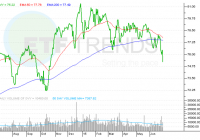Sector Factors To Consider With Dividend ETFs
Summary Dividend stock ETFs have been losing assets as Treasuries sold off and yields rose. The selling pressure in dividends provides a warning for what could occur in a rising rate environment. A good chunk of dividend ETF portfolios are allocated in utility stocks, which are sensitive to changes in interest rates. By Todd Shriber & Tom Lydon Thanks to the jump in Treasury yields, a rise that has been fueled by speculation the Federal Reserve will soon raise interest rates, investors are departing some noteworthy dividend exchange traded funds. Of the four largest dividend ETFs, only the Vanguard High Dividend Yield ETF (NYSEArca: VYM ) has seen inflows this year, while the iShares Select Dividend ETF (NYSEArca: DVY ) is the worst outflows offender of the four due in part to its 31.5% weight to the lagging utilities sector. Once the Federal Reserve hikes interest rates, U.S. dividend stocks and exchange traded funds could experience a meaningful correction after investors piled into the yield-paying assets during the low rate environment. That is particularly true of dividend ETFs with big weights to rate-sensitive utilities and real estate stocks. Reports Chris Dieterich for Barron’s : Part of the concern: All that money that’s flowed in over the past six years could be yanked out just as quickly, as investors scramble to take profits at the first whiff of market trouble. That’s happened twice over the past two years, first in 2013 and again in the past few months, when the stocks that have fallen hardest were those with the highest yields. Take utilities, the highest yielders among the S&P 500’s 10 industry groups. Utility stocks on the S&P 500 are fresh off a 6.7% plunge in the second quarter, the worst of any U.S. stock sector, while the S&P 500 overall was flat. With Treasury yields climbing, utilities-heavy dividend ETFs are lagging. For example, DVY is off nearly 3% this year while the S&P 500 is up 1.8%. The First Trust Value Line Dividend Index Fund (NYSEArca: FVD ) has lost 1.2% thanks to an almost 23.75 weight to utilities stocks, indicating investors have mistakenly added over $118 million to that ETF this year. On the bright side, recent history shows dividend ETFs can whether the rising Treasury yields storm. That happened in 2013 when Treasury yields surged, but DVY and FVD gained an average of 27.8%, though that lagged the 32.3% returned by the S&P 500. The caveat with 2013 is that the Utilities Select Sector SPDR (NYSEArca: XLU ) gained more than 10%, a feat unlikely to be repeated this year. DVY remains alluring for income ETFs , in part due to a screening methodology that includes dividend growth and payout ratios. However, stock selection by yield could make DVY vulnerable to increased lethargy if Treasury yields continue higher. FVD follows the Value Line Dividend Index, which equally weights components and utilizes the proprietary Value Line research to select components. Specifically, stocks are ranked by the Value Line Safety Ranking of 1 or 2 out of 5, which are based on price stability and financial strength. Additionally, the index excludes stocks with a dividend yield lower than the S&P 500. iShares Select Dividend ETF (click to enlarge) Tom Lydon’s clients own shares of DVY. Disclosure: I am/we are long DVY. (More…) I wrote this article myself, and it expresses my own opinions. I am not receiving compensation for it. I have no business relationship with any company whose stock is mentioned in this article.
